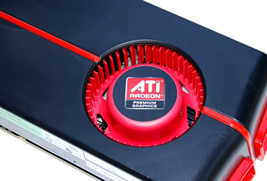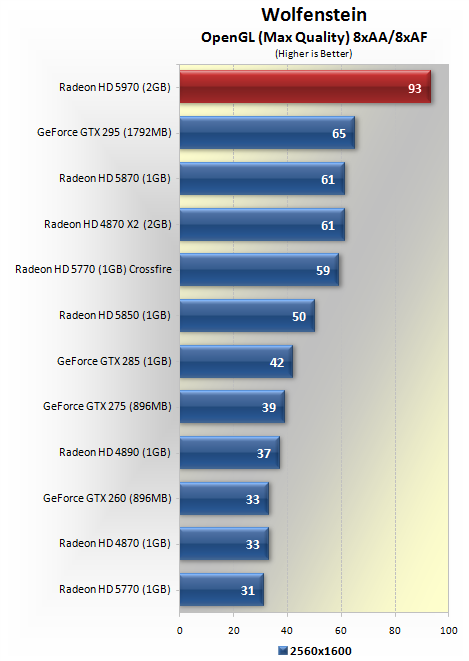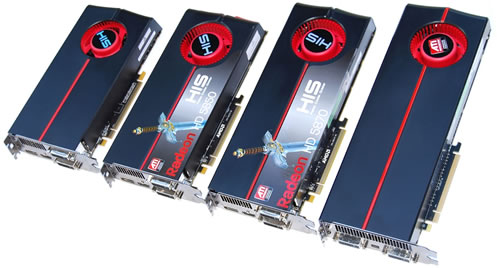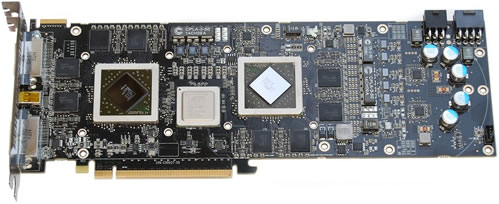ATI Radeon HD 5970 Review: Dual-GPU Graphics


ATI revealed its last generation Radeon 5000 graphics family last September, when we got the chance to review the ATI Radeon HD 5870, and what a treat that was.
In a few tests the single-GPU Radeon HD 5870 was able to outgun the mighty GeForce GTX 295, while in most it managed to match or improve upon the Radeon HD 4870 X2. As you are likely aware, both of these products carry dual GPUs, which bring a number of implications, not to mention bigger price tags.
Looking forward we knew Nvidia would have no immediate response to the new Radeons, while on the other hand ATI was not done unleashing its full series of products. Subsequently we looked at two more products that were meant to underperform the flagship HD 5870: the slightly cut down Radeon HD 5850 and the mainstream aimed HD 5770.
But as we discussed in our preliminary Radeon 5870 review, on the horizon was also a follow-up to the Radeon HD 4870 X2, code-named "Hemlock XT", which in essence would put together a pair of Radeon HD 5870 GPUs on a single PCB.
Today AMD is officially unveiling the Hemlock as the new ATI Radeon HD 5970, hoping to expand its current dominance in single-GPU performance with the fastest single-slot graphics card on the market -- a title that until today was reserved for Nvidia's dual-GPU GeForce GTX 295.
The Radeon HD 5970 looks to be well suited for the job. The GPUs used in this card use exactly the same configuration found on the Radeon HD 5870, while core and memory frequencies match those of the Radeon HD 5850. This provides the HD 5970 with an unmatched memory bandwidth of 256GB/s.
All this horsepower will come at a hefty price, as AMD expects to charge as much as $600 for it. This is a bit hard to swallow, but all things considered it's about where we expected it to stand among the rest of high-end graphics offerings.
The $400 Radeon HD 5870 is still sold out virtually everywhere due to extreme shortages. The Radeon HD 5850 version still costs $300, meaning that a pair of them would cost the same amount as a single Radeon HD 5970, and we do not expect the performance to be nearly as good. On the other side of the equation, Nvidia's top performer, the GeForce GTX 295 is selling for around $500.
As we see it, only extreme users looking for the best possible gaming experience - or the bragging rights attached to the label - will find the Radeon HD 5970 to make complete sense.
Knowing this is the 5970's intended market, AMD has stamped a big "unlocked" label over the card in our press kit. Perhaps more marketing buzz than actual functionality, the Radeon HD 5970 allows you to jack core and memory frequencies as high as you like -- or at least as high as they will go without compromising stability. This in itself is far from exciting news as there's been software available to do just that for ages.
The most interesting part should come from the ability to adjust voltages and thus increase the card's overclocking room, something we'll be checking in detail next.
Radeon HD 5970: The Card In Detail
The Radeon HD 5970 is a truly massive graphics card, even for a high-end dual-GPU product. Its dimensions whale anything previously seen, measuring in at 30cm long and weighing a little over 1kg.
Our review sample hung a total of 6cm off the edge of our Asus P6T Deluxe motherboard used for testing.



Cooling the Hemlock XT GPUs is a large aluminum heatsink made up of 36 fins. Measuring 16cm long, 7cm wide, and 2.5cm tall, it is slightly larger than that used in the Radeon HD 5870. Connected to the base of this heatsink is a massive copper plate which helps improve efficiency, while a 75x20mm blower fan draws air in from within the case and pushes it out through the rear of the graphics card.
For the most part this fan operates very quietly, helped by the impressively low 42 watt idle consumption of the Radeon HD 5970. When gaming, the fan will inevitably spin up as the card can consume up to 294 watts under load, but even with the increased thermal stress the 5970 does not scream at intolerable levels.

The heatsink and fan have been enclosed within a custom built housing that conceals the entire graphics card, which is the same design used with the Radeon HD 5870. This setup helps protect the card very well; Nvidia has been using similar enclosures for some time with their most prized graphics cards, such as the GTX 295.

Removing the heatsink exposes the two GPUs, GDDR5 memory chips, and a few other critical components.
With the heatsink off the Radeon HD 5970 looks almost identical to the Radeon HD 4870 X2, though it is noticeably longer.

Key changes involve the new GDDR5 memory, improved power circuitry, and an updated 2.0 PEX bridge from PLX Technologies, used to link the GPUs together. All this hardware is cooled via the large heatsink that covers the majority of the card’s 30cm long PCB.
GDDR5 memory works at an ever more impressive frequency (1.0GHz x 4) on this particular model, which features a total capacity of 2GB. The core configuration of the Radeon HD 5970 doubles everything in the 4870 X2 with 1600 (320x5) SPUs, 80 TAUs (Texture Address Units), and 32 ROPs (Rasterization Operator Units).

AMD’s reference card came equipped with Hynix ICs (H5GQ1H24AFR-T2C parts). These GDDR5 modules are rated for 1.25GHz operation, so we expect to push them beyond the stock 1.0GHz configuration without hassle.

In order to feed the graphics card enough power, a pair of PCI Express power connectors are used (6-pin and 8-pin sockets). This is the same configuration used by previous dual-GPU graphics cards such as the GeForce 9800 GX2 and Radeon HD 4870 X2, so current high-end power supplies should cater for this new graphics card.

The Radeon HD 5970 naturally supports CrossfireX technology, and therefore in the standard position we find a single connector for bridging two cards together.
The only other connectors can be found on the I/O panel. Our sample featured two dual-DVI connectors and a Mini Display Port connection. Just like the Radeon HD 5870, the 5970 can support a maximum resolution of 2560x1600 on not one but rather three monitors.




Already the Radeon HD 5970 is starting to look impressive. With a 3Dmark score of 9238pts at 2560x1600, it has not only set a new record for single PCB graphics cards, but also managed to outperform both the GeForce GTX 295 and Radeon HD 5870 by comfortable margins of 37% and 48% respectively.
Furthermore the previous generation AMD flagship card, the Radeon HD 4870 X2, was blown away by a 62% margin. We're eager to see how this numbers translate into real-world gaming performance.



While the Radeon HD 4870 X2 and Radeon HD 5770 Crossfire both showed impressive gains over their single GPU counterparts, the new Radeon HD 5970 struggled to outpace the Radeon HD 5870.
At 2560x1600 it was just 10% faster, which is a bit worrying considering how the game’s engine has typically worked well with Crossfire technology. Hopefully this won’t become a trend throughout the rest of our tests.



Batman Arkham Asylum is a controversial game to benchmark with, as anti-aliasing in this game strongly favors Nvidia based graphics cards. By removing this visual setting the problem is easily eliminated, though it brings about another small problem: even at 2560x1600 mid-range graphics cards are not exactly put to the test.
The game is also based on the aging Unreal Engine 3, though it is said to use the 3.5 version which features a few upgrades. Still, this shouldn’t provide much trouble for the Radeon HD 5970.
Despite not being a particularly demanding game, Batman Arkham Asylum should demonstrate how various graphics cards scale using this engine -- and the Radeon HD 5970 cleans up. At the maximum tested resolution the Radeon HD 5970 is 27% faster than the GeForce GTX 295 and 58% faster than the Radeon HD 5870. Obviously with an average of 168fps the Radeon HD 5970 has no problems with Batman Arkham Asylum using maximum in-game quality settings with AA/AF disabled.












Power Consumption & Temperatures


Credit : www.techspot.com
Our review sample hung a total of 6cm off the edge of our Asus P6T Deluxe motherboard used for testing.



Cooling the Hemlock XT GPUs is a large aluminum heatsink made up of 36 fins. Measuring 16cm long, 7cm wide, and 2.5cm tall, it is slightly larger than that used in the Radeon HD 5870. Connected to the base of this heatsink is a massive copper plate which helps improve efficiency, while a 75x20mm blower fan draws air in from within the case and pushes it out through the rear of the graphics card.
For the most part this fan operates very quietly, helped by the impressively low 42 watt idle consumption of the Radeon HD 5970. When gaming, the fan will inevitably spin up as the card can consume up to 294 watts under load, but even with the increased thermal stress the 5970 does not scream at intolerable levels.

The heatsink and fan have been enclosed within a custom built housing that conceals the entire graphics card, which is the same design used with the Radeon HD 5870. This setup helps protect the card very well; Nvidia has been using similar enclosures for some time with their most prized graphics cards, such as the GTX 295.

Removing the heatsink exposes the two GPUs, GDDR5 memory chips, and a few other critical components.
With the heatsink off the Radeon HD 5970 looks almost identical to the Radeon HD 4870 X2, though it is noticeably longer.

Key changes involve the new GDDR5 memory, improved power circuitry, and an updated 2.0 PEX bridge from PLX Technologies, used to link the GPUs together. All this hardware is cooled via the large heatsink that covers the majority of the card’s 30cm long PCB.
GDDR5 memory works at an ever more impressive frequency (1.0GHz x 4) on this particular model, which features a total capacity of 2GB. The core configuration of the Radeon HD 5970 doubles everything in the 4870 X2 with 1600 (320x5) SPUs, 80 TAUs (Texture Address Units), and 32 ROPs (Rasterization Operator Units).

AMD’s reference card came equipped with Hynix ICs (H5GQ1H24AFR-T2C parts). These GDDR5 modules are rated for 1.25GHz operation, so we expect to push them beyond the stock 1.0GHz configuration without hassle.

In order to feed the graphics card enough power, a pair of PCI Express power connectors are used (6-pin and 8-pin sockets). This is the same configuration used by previous dual-GPU graphics cards such as the GeForce 9800 GX2 and Radeon HD 4870 X2, so current high-end power supplies should cater for this new graphics card.

The Radeon HD 5970 naturally supports CrossfireX technology, and therefore in the standard position we find a single connector for bridging two cards together.
The only other connectors can be found on the I/O panel. Our sample featured two dual-DVI connectors and a Mini Display Port connection. Just like the Radeon HD 5870, the 5970 can support a maximum resolution of 2560x1600 on not one but rather three monitors.
Test System Specs & 3Dmark Vantage
| Core i7 Test System Specs - Intel Core i7 965 Extreme Edition (Overclocked @ 3.70GHz) - x3 2GB G.Skill DDR3 PC3-12800 (CAS 9-9-9-24) - Asus P6T Deluxe (Intel X58) - OCZ GameXStream (700 watt) - Seagate 500GB 7200-RPM (Serial ATA300) - ATI Radeon HD 5970 (2GB) - HIS Radeon HD 5870 (1GB) - HIS Radeon HD 5850 (1GB) - HIS Radeon HD 5770 (1GB) - VisionTek Radeon HD 4870 X2 (2GB) - Asus Radeon HD 4890 (1GB) - Palit Radeon HD 4870 (1GB) - Asus GeForce GTX 295 (1792MB) - Asus GeForce GTX 285 (1GB) - Asus GeForce GTX 275 (896MB) - Palit GeForce GTX 260 (896MB) Software - Microsoft Windows 7 Ultimate (64-bit) - Nvidia Forceware 191.03 - ATI Catalyst 9.10 |




Already the Radeon HD 5970 is starting to look impressive. With a 3Dmark score of 9238pts at 2560x1600, it has not only set a new record for single PCB graphics cards, but also managed to outperform both the GeForce GTX 295 and Radeon HD 5870 by comfortable margins of 37% and 48% respectively.
Furthermore the previous generation AMD flagship card, the Radeon HD 4870 X2, was blown away by a 62% margin. We're eager to see how this numbers translate into real-world gaming performance.
Benchmarks: Unreal Tournament 3, Batman Arkham Asylum



While the Radeon HD 4870 X2 and Radeon HD 5770 Crossfire both showed impressive gains over their single GPU counterparts, the new Radeon HD 5970 struggled to outpace the Radeon HD 5870.
At 2560x1600 it was just 10% faster, which is a bit worrying considering how the game’s engine has typically worked well with Crossfire technology. Hopefully this won’t become a trend throughout the rest of our tests.



Batman Arkham Asylum is a controversial game to benchmark with, as anti-aliasing in this game strongly favors Nvidia based graphics cards. By removing this visual setting the problem is easily eliminated, though it brings about another small problem: even at 2560x1600 mid-range graphics cards are not exactly put to the test.
The game is also based on the aging Unreal Engine 3, though it is said to use the 3.5 version which features a few upgrades. Still, this shouldn’t provide much trouble for the Radeon HD 5970.
Despite not being a particularly demanding game, Batman Arkham Asylum should demonstrate how various graphics cards scale using this engine -- and the Radeon HD 5970 cleans up. At the maximum tested resolution the Radeon HD 5970 is 27% faster than the GeForce GTX 295 and 58% faster than the Radeon HD 5870. Obviously with an average of 168fps the Radeon HD 5970 has no problems with Batman Arkham Asylum using maximum in-game quality settings with AA/AF disabled.
Benchmarks: Section 8, The Last Remnant



Section 8 is another game based on the original Unreal Engine 3, and again while other Crossfire setups show reasonable performance gains, the Radeon HD 5970 was just 9% faster than the Radeon HD 5870 at 2560x1600. Although this did make the Radeon HD 5970 the fastest graphics card tested, we are hoping to see significantly larger performance gaps between it and its single GPU version.



In The Last Remnant, our last test using the Unreal Engine 3, we see a decent performance margin favoring the Radeon HD 5970 when compared to the Radeon HD 5870. At 2560x1600 the card was 58% faster than the Radeon HD 5870, while it also managed to edge out the GeForce GTX 295 by a 15% margin.
Benchmarks: Wolfenstein, Enemy Territory: Quake Wars



Wolfenstein is one of the newer games in our review and it uses a heavily modified version of the id Tech 4 game engine. At 2560x1600, we were pleased to see that the Radeon HD 5970 was 52% faster than the Radeon HD 5870. This also meant that the Radeon HD 5970 was 43% faster than the GeForce GTX 295 and 52% faster than the Radeon HD 4870 X2. With an average of 93fps at this extreme resolution, the Radeon HD 5970 managed to make the GeForce GTX 295 look slow.



Enemy Territory: Quake Wars employs the original id Tech 4 game engine. Despite it being quite old and testing with maximum in-game quality settings as well as 8xAA/16xAF enabled, the Radeon HD 5970 averaged a staggering 158fps at 2560x1600. This translated to a 49% performance margin over the Radeon HD 5870 and 55% over the Radeon HD 4870 X2.

In terms of power usage the Radeon HD 5970 is hungry, which was to be expected. With a total system consumption level of 498 watts, the Radeon HD 5970 used slightly less power than the Radeon HD 4870 X2, while consuming 8% more than the GeForce GTX 295.
The Radeon HD 5970 does only use 26% more power than the Radeon HD 5870, which we found startling.

The operating temperature of the Radeon HD 5970 is well within acceptable levels, with an idle temp of 60 degrees. Under load the card heated up to 87 degrees. This stress temperature placed the Radeon HD 5970 alongside the GeForce GTX 275 and the Radeon HD 5870.
The surprising part is that under load the Radeon HD 5970 appeared to generate roughly the same amount of noise as the GeForce GTX 275 and Radeon HD 5870 graphics cards.
Overclocking Performance
Adding value to the Radeon HD 5970 are its stock overclocking abilities that helped us squeeze almost 20% more performance out of it at 2560x1600. The ability to adjust the voltage of any Radeon HD 5970 card should come as a bonus to enthusiast-level consumers and extreme gamers, though we hope AMD is working on providing better software for the consumer.



Although we finished off with a 25% core and memory overclock, it came far from easy using a beta version of the Catalyst drivers. After what seemed like endless stuffing around we achieved a stable overclock with the core running at 900MHz and the memory at 1250MHz.

Overclocking improved the 3Dmark Vantage score at 2560x1600 by 20% as the Radeon HD 5970 was awarded 11099pts. This made the Radeon some 65% faster than the GeForce GTX 295, which was the next fastest graphics card tested.

Company of Heroes Opposing Fronts allowed for a 17% performance increase at 2560x1600 when overclocking the Radeon HD 5970.

The only other game we had time to test after finally achieving a decent overclock was S.T.A.L.K.E.R.: Call of Pripyat where we saw healthy performance gains again. The performance at 2560x1600 was increased by 18% making the Radeon HD 5970 around 78% faster than the Radeon HD 5870.
Final Thoughts
As expected the Radeon HD 5970 is vastly superior to the GeForce GTX 295 in terms of performance beating it in every single test, at all tested resolutions.
On average the Radeon HD 5970 was 53% faster than the GeForce GTX 295 at 2560x1600. Even removing the top three tests where the Radeon led with the biggest margins (BattleForge, Enemy Territory and Street Fighter IV), the HD 5970 still ended up some 34% faster than the GTX 295.
It's easy to conclude from there that the Radeon HD 4870 X2 presented no contention whatsoever, and that ATI's latest dual-GPU Radeon can claim the title of the fastest graphics card currently in the market.
Another interesting statistic is that the Radeon HD 5970 was on average 46% faster than the Radeon HD 5870, while costing 50% more. Assuming that you can increase the core frequency of the Radeon HD 5970 by at least 17% and the memory by 20%, then you can effectively produce a pair of Radeon HD 5870 GPUs in a single board. Once again, for those who can justify the price, we feel that the Radeon HD 5970 provides enthusiast users with a viable alternative towards extreme performance.
It should be noted that under load the Radeon HD 5970 operated at an acceptable volume when running at its default specifications, but this wasn't the case when overclocking. In order to keep the GPUs at safe temperatures, the blower fan was working overtime and in the process created so much noise it was impossible to hear myself think. Those looking into overclocking the already super-fast Radeon HD 5970 will need to delve into alternative cooling methods such as water.
The Radeon HD 5970 is also the largest graphics card we've ever tested with a length of 30cm, it's larger than the 4870 X2 or the GTX 295. This card is not going to be compatible with a wide range of computer cases, so those looking at purchasing it should first make sure their case can accommodate for the EATX (extended ATX) form factor, which measures 30.5cm wide, or roughly the same dimension as the Radeon HD 5970.
Like all multi-GPU graphics cards, the Radeon HD 5970 relies heavily on driver support to perform as intended. Every time a new game is released it is likely that the Radeon HD 5970 will not fully support it (taking advantage of the two GPUs) until AMD updates the Catalyst driver. I'm usually skeptical about multi-GPU technology as the results tend to vary a lot, though admittedly things have improved considerably from where we were a year ago.
Without full Crossfire support the Radeon HD 5970 will perform somewhere in between a single Radeon HD 5870 and 5850 graphics card, which is still pretty decent.
Make it official, the Radeon HD 5970 is the fastest graphics card in the market, outperforming by a long shot previous generation dual-GPU products. We can't decide for you whether it makes sense to spend $600 on this graphics card or not, but at least it's nice having the option.
The next step for AMD/ATI is not to work on their next-generation products, as it is making sure the current Radeons are widely available from retailers. We sure hope the Radeon HD 5970 does not become a soft launch, following the inventory debacle seen with the rest of the series. So, inventory first and working around the drivers' rough edges should make this a great purchase for those who can afford it.
Credit : www.techspot.com



No comments:
Post a Comment